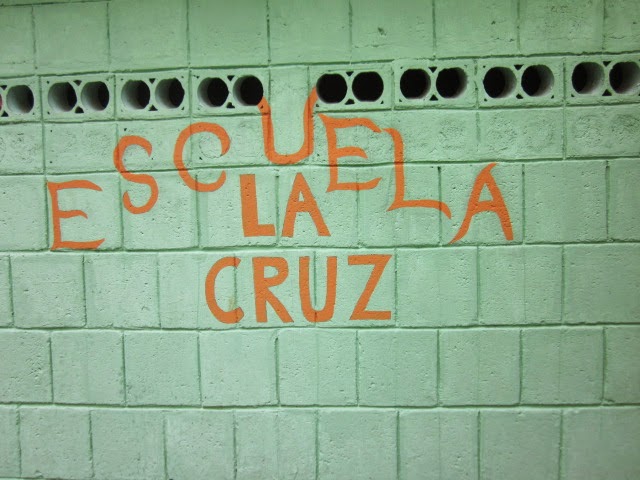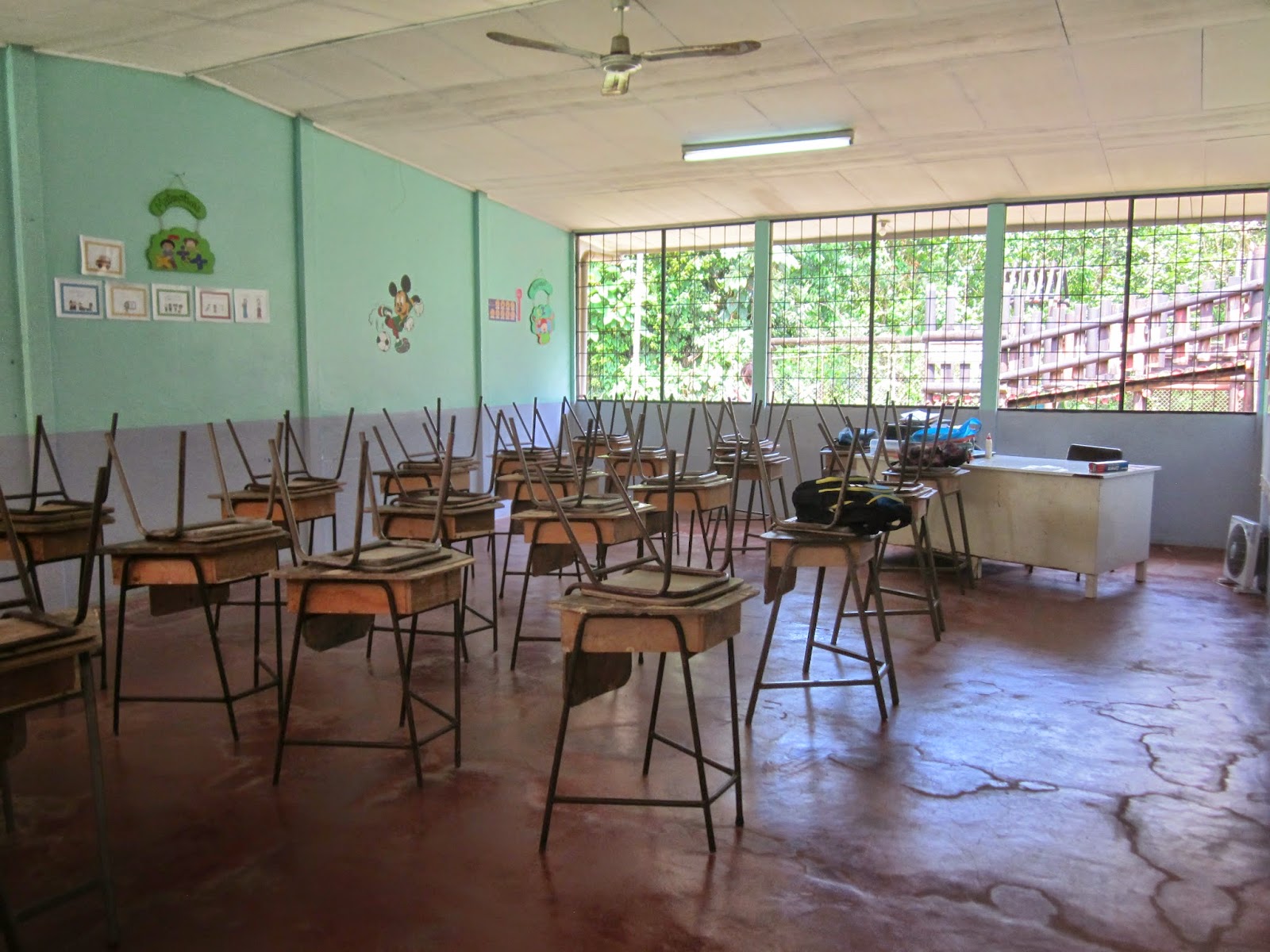 |
| CABLE SYSTEM AT WORK |
Saturday, February 28, 2015
Bananas.....
Plenty of banana plantations between Arenal and Tortuguero. Chiquita and Dole sound familiar? It is an amazing set up. Bananas are tagged and covered with plastic bags, when ready to be picked they are placed on rails that move around and travel across the street to the packing area.
Hiking in the Forest.......
Hiking through The Santa Elena cloud forest was so cool. A rainy morning as we got rigged out and off we set. The magic and mist takes over and you can't help but be at peace. Walking and watching for animal presence while taking in all the flowers and fauna forces one to slow down, observe, and be present. It's not like the many animals, insects, mammals,and birds are poised and waiting to entertain and to pose for us humans! We are the visitors in their territory, if we are lucky we will see them in their natural habitat.
Not too much action from our animal friends on this rainy misty day. Still so much beauty everywhere.
La Selva Biological Station (project of the Organization of Tropical Studies, a research consortium of 63 U.S. , Australian and Latin American Universities)
We had the opportunity to do a day and night hike here. In 6 square miles: 420 bird species, 460 tree species, and 400 butterfly species. We saw so much activity on both hikes.
Leafcutter ants, pecaris roaming around, Blue Jean dart frog, insects, sloths, katydids, praying mantis, howler monkeys, Coti and many exquisite birds.

Afternoon hike on trail at rear of lodge in Tortuguero up to a lookout where we could see an aerial view of the converging canals along with an abundance of butterflies, insects, dragonflies. Spider monkeys, howler monkeys practically playing in your backyard. Amazing!
Not too much action from our animal friends on this rainy misty day. Still so much beauty everywhere.
La Selva Biological Station (project of the Organization of Tropical Studies, a research consortium of 63 U.S. , Australian and Latin American Universities)
We had the opportunity to do a day and night hike here. In 6 square miles: 420 bird species, 460 tree species, and 400 butterfly species. We saw so much activity on both hikes.
Leafcutter ants, pecaris roaming around, Blue Jean dart frog, insects, sloths, katydids, praying mantis, howler monkeys, Coti and many exquisite birds.

Afternoon hike on trail at rear of lodge in Tortuguero up to a lookout where we could see an aerial view of the converging canals along with an abundance of butterflies, insects, dragonflies. Spider monkeys, howler monkeys practically playing in your backyard. Amazing!
Tuesday, February 24, 2015
Sharing Costa Rica at school
There was so much excitement on our first day back at school.
One student greeted me with, "Well did your alarm clock wake you up in the rainforest"?
Impressive that he remembered that the howler monkeys would be our alarm clock.
Well, the howler monkeys did not make a lot of noise early in the morning but could be heard away in the distance while we were out bird watching, or taking an early morning hike.
We looked at a slideshow of animals, flowers and faunas. Lots of questions and time for discussions.
We read two fantastic books: "Green" by Laura Vaccaro Seeger and "Swirl by Swirl: Spirals in Nature" by Joyce Sidman and Beth Krommes
After reading these books, our art project was a painting vines using various shades of green and swirling strokes with a paintbrush.
Looking at pictures of Costa Rica.
Sorting and classifying animals of the Rain Forest.
All you need to make your own tree is paper, tape, markers, help of a friend(s) and persistence.

"Vine Painting"
Our next activity will be to crack open a coconut and sample what is inside. We also have a pineapple, mango and avocado to taste and comment.
2/25/15
Opening the coconut went smoothly with the help of a philips screwdriver and a hammer, the students had turns hammering and we got it open, we sampled the coconut water - sweet, and eat the meat - chewy.
3/9/2015
We continue immersing Costa Rica, the rain forest and animal/plant life in our classroom. We have also been learning about local forests here in New England and the life that is present. We have looked at Habitats, where do humans live, animals and what we all need for survival.. Layers of the forest, adaptation and camouflage continue to intrigue us. Sculpey snakes and insects are on the menu this week and then we will make a painting that camouflages our sculpey creations.
One student greeted me with, "Well did your alarm clock wake you up in the rainforest"?
Impressive that he remembered that the howler monkeys would be our alarm clock.
Well, the howler monkeys did not make a lot of noise early in the morning but could be heard away in the distance while we were out bird watching, or taking an early morning hike.
We looked at a slideshow of animals, flowers and faunas. Lots of questions and time for discussions.
We read two fantastic books: "Green" by Laura Vaccaro Seeger and "Swirl by Swirl: Spirals in Nature" by Joyce Sidman and Beth Krommes
After reading these books, our art project was a painting vines using various shades of green and swirling strokes with a paintbrush.
Looking at pictures of Costa Rica.
Sorting and classifying animals of the Rain Forest.
All you need to make your own tree is paper, tape, markers, help of a friend(s) and persistence.

"Vine Painting"
Our next activity will be to crack open a coconut and sample what is inside. We also have a pineapple, mango and avocado to taste and comment.
2/25/15
Opening the coconut went smoothly with the help of a philips screwdriver and a hammer, the students had turns hammering and we got it open, we sampled the coconut water - sweet, and eat the meat - chewy.
3/9/2015
We continue immersing Costa Rica, the rain forest and animal/plant life in our classroom. We have also been learning about local forests here in New England and the life that is present. We have looked at Habitats, where do humans live, animals and what we all need for survival.. Layers of the forest, adaptation and camouflage continue to intrigue us. Sculpey snakes and insects are on the menu this week and then we will make a painting that camouflages our sculpey creations.
On the water.
Early morning kayaking on Lake Arenal in the warm rain and mist.
Boat rides day and night on the Tortuguero canals; lots to see in the water and on the banks. Caimans featured prominently as did egrets, herons, hawks, lizards and insects.
Boat rides day and night on the Tortuguero canals; lots to see in the water and on the banks. Caimans featured prominently as did egrets, herons, hawks, lizards and insects.
Education
We had the pleasure of visiting two schools while in Costa Rica.
The first school, Escuela La Cruz, had ten students and one teacher. We arrived on Saturday and were delighted the students and family members all turned up in beautiful costumes and danced for us. We also enjoyed refreshments and had an opportunity to interact with the students.
Playground fun!!!!

The next school Trinity had approximately 90 students and teachers. The school day runs.s from 7-11 with a break from 12-1 at which time students walk home as they usually live within walking distance and then resume schooling from 12-4. The kindergartners have a shorter day. They wear uniforms; crisp white shirts and navy skirts or pants (boys). Kindergarteners wear a sky blue shirt and skirt and pants.
Their school year runs from February to December. The government provides a lunch at a cost of $1.50 per child per day.
Trinity school currently receives a budget of $57,000 for supplies and maintenance not enough to keep up with repairs as we found out the electrical system is in need of updating. We brought supplies to both schools which were much appreciated. Hopefully, we can fundraise so we can help these schools.
I got to be part of an art class at Trinity which was going on outdoors. The art teacher Carlos was very welcoming and I did a simple folding and cutting activity, a snow flake, the children had never experienced snow! I really enjoyed the my time with them.
The students also performed a series of beautiful dances for us complete with exquisite costumes.
What struck me as we approached the school was the sea of happy faces. The students exuded joy. What an uplifting experience.
The first school, Escuela La Cruz, had ten students and one teacher. We arrived on Saturday and were delighted the students and family members all turned up in beautiful costumes and danced for us. We also enjoyed refreshments and had an opportunity to interact with the students.
Playground fun!!!!

The next school Trinity had approximately 90 students and teachers. The school day runs.s from 7-11 with a break from 12-1 at which time students walk home as they usually live within walking distance and then resume schooling from 12-4. The kindergartners have a shorter day. They wear uniforms; crisp white shirts and navy skirts or pants (boys). Kindergarteners wear a sky blue shirt and skirt and pants.
Their school year runs from February to December. The government provides a lunch at a cost of $1.50 per child per day.
Trinity school currently receives a budget of $57,000 for supplies and maintenance not enough to keep up with repairs as we found out the electrical system is in need of updating. We brought supplies to both schools which were much appreciated. Hopefully, we can fundraise so we can help these schools.
I got to be part of an art class at Trinity which was going on outdoors. The art teacher Carlos was very welcoming and I did a simple folding and cutting activity, a snow flake, the children had never experienced snow! I really enjoyed the my time with them.
The students also performed a series of beautiful dances for us complete with exquisite costumes.
What struck me as we approached the school was the sea of happy faces. The students exuded joy. What an uplifting experience.
Subscribe to:
Comments (Atom)




 Cable system to carry bananas to packing plant.
Cable system to carry bananas to packing plant.


























.jpg)
.jpg)




















